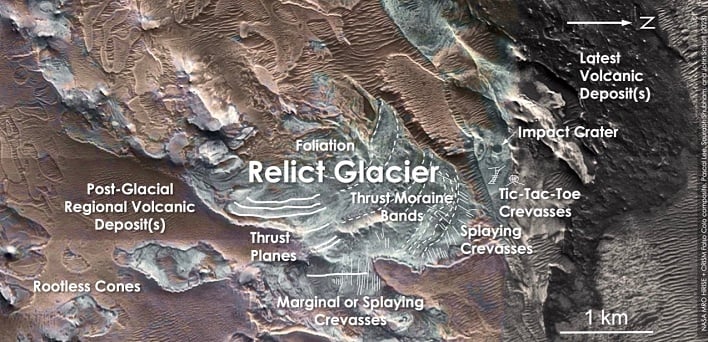This Groundbreaking Discovery On Mars Has Major Implications For Human Exploration
As NASA and others continue to work toward human exploration and habitation of Mars, one question has been ever present, "Where is the best place to land and begin such an endeavor?" One of the more pressing components of an ideal landing location is where the best possibility of finding a viable water source is. Higher latitude sites have been the most likely candidates, but those regions are challenging due to how cold they are. However, a recent discovery of a relict glacier near the planet's equator could provide a more ideal place to begin human exploration.
The discovery of the relict glacier is significant in that it implies the presence of surface water on Mars in recent times near the Martian equator. This means that there could actually be ice that still exists at shallow depths in the region.
"What we've found is not ice, but a salt deposit with the detailed morphologic features of a glacier. What we think happened here is that salt formed on top of a glacier while preserving the shape of the ice below, down to details like crevasse fields and moraine bands," explained Dr. Pascal Lee, a planetary scientist with the SETI Institute and the Mars Institute, and lead author of the study.

"This region of Mars has a history of volcanic activity. And where some of the volcanic materials came in contact with glacier ice, chemical reactions would have taken place at the boundary between the two to form a hardened layer of sulfate salts," remarked Sourabh Shubham, a graduate student at the University of Maryland's Department of Geology, and co-author of the study. "This is the most likely explanation for the hydrated and hydroxylated sulfates we observe in this light-toned deposit."
There are still a few unknowns with the new discovery. It is not certain whether ice might still be presently preserved underneath the light-toned deposit, or if it has disappeared entirely. Lee says it is not surprising that researchers are not finding any water ice at the surface. He says it is possible that some of it is still protected at shallow depths under the sulfate salts.
This could be monumental for future explorations and possible habitation of the Red Planet in the future. However, Lee cautions, "We now have to determine if, and how much, water ice might actually be present in this relict glacier, and whether other light-toned deposits might also have, or have had, ice-rich sulfates."


